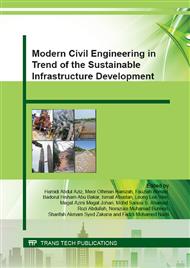[1]
G. Li, M.A. Stubblefield, G. Garrick, J. Eggers, C. Abadie, B. Huang, Development of waste tyre modified concrete. Cement and Concrete Research 34(12), 2004, 2283-2289.
DOI: 10.1016/j.cemconres.2004.04.013
Google Scholar
[2]
P.R. Rangaraju, S. Gadkar, Durability evaluation of crumb rubber addition rate on Portland cement concrete. Clemson University report; (unpublished), (2012).
Google Scholar
[3]
F. Pelisser, N. Zavarise, T.A. Longo, A.M. Bernardin, Concrete made with recycled tyre rubber: effect of alkaline activation and silica fume addition. Journal of Cleaner Production 19(6), 2011, 757-763.
DOI: 10.1016/j.jclepro.2010.11.014
Google Scholar
[4]
L.H. Chou, C.N. Lin, C.K. Lu, C.H. Lee, M.T. Lee, Improving rubber concrete by waste organic sulfur compounds. Waste Management & Research 28(1), 2010, 29-35.
DOI: 10.1177/0734242x09103843
Google Scholar
[5]
X. Colom, F. Carrillo, J. Canavate, Composites reinforced with reused tyres: surface oxidant treatment to improve the interfacial compatibility. Composites Part A: Applied Science and Manufacturing 38(1), 2007, 44-50.
DOI: 10.1016/j.compositesa.2006.01.022
Google Scholar
[6]
N. Segre, I. Joekes, Use of tyre rubber particles as addition to cement paste. Cement and Concrete Research 30(9), 2000, 1421-1425.
DOI: 10.1016/s0008-8846(00)00373-2
Google Scholar
[7]
Z. Li, F. Li, J. Li, Properties of concrete incorporating rubber tyre particles. Magazine of Concrete Research 50(4), 1998, 297-304.
DOI: 10.1680/macr.1998.50.4.297
Google Scholar
[8]
World Growth Palm Oil Green Development Campaign: Palm Oil — The Sustainable Oil a Report by World Growth September 2009. Available on line at <http: /www. worldgrowth. org/assets/files/Palm_Oil. pdf>, (accessed 25 June 2014).
DOI: 10.1016/j.worlddev.2021.105710
Google Scholar
[9]
American Society for Testing and Materials, ASTM C109: Standard test method for compressive strength of hydraulic cement mortars (Using 2-in. or [50-mm] cube specimens), 2005, West Conshohocken, PA.
DOI: 10.1520/c0109_c0109m-20
Google Scholar
[10]
American Society for Testing and Materials, ASTM C1437: Standard test method for flow of hydraulic cement mortar, 2007, West Conshohocken, PA.
Google Scholar
[11]
American Society for Testing and Materials, ASTM C496: Standard specification for split tensile strength of cylindrical concrete specimens, 2004, West Conshohocken, PA.
Google Scholar
[12]
American Society for Testing and Materials, ASTM C348: Standard specification for flexural strength of hydraulic-cement mortars, 2008, West Conshohocken, PA.
Google Scholar
[13]
Khatib, Z. K., & Bayomy, F. M.,. Rubberized Portland cement concrete. Journal of Materials in Civil Engineering, 11(3), 1999, 206-213.
DOI: 10.1061/(asce)0899-1561(1999)11:3(206)
Google Scholar


